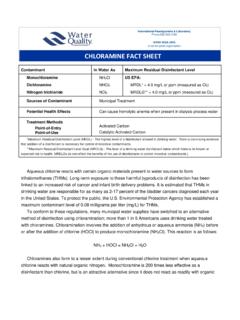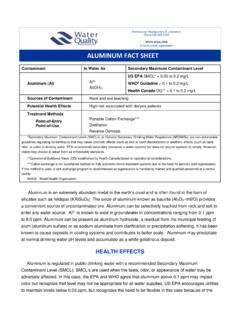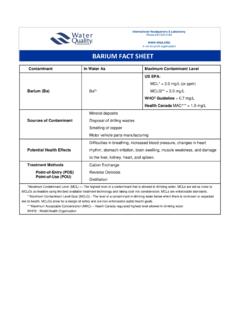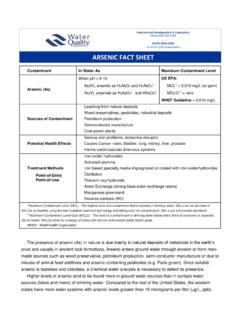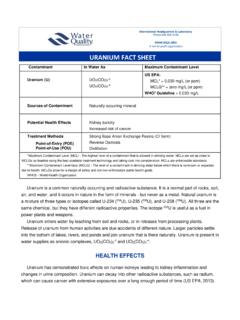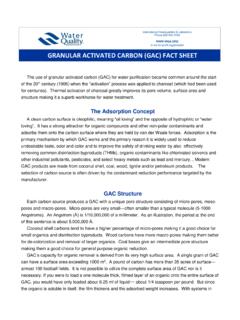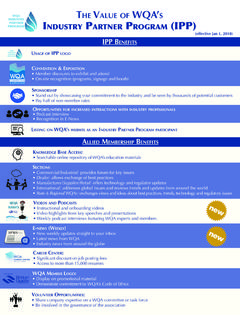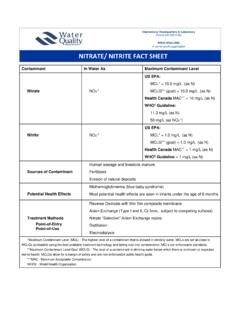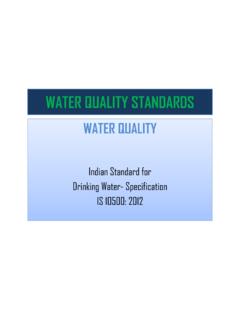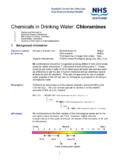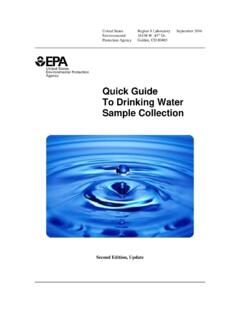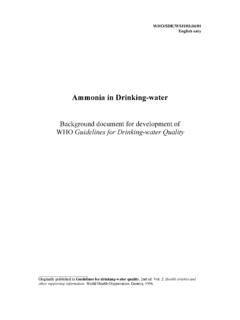Transcription of AMMONIA FACT SHEET - Water Quality Association
1 Contaminant In Water As Maximum Contaminant Level* AMMONIA (NH3) pH dependent: NH4+ NH3 No US EPA action levels or WHO guidelines have been established. Sources of Contaminant Disinfection with chloramines Wastes, Fertilizers & Natural processes Potential Health Effects None proposed for human but toxic for aquatic life Treatment Methods Point-of-Entry Point-of-Use Ion Exchange with zeolite Sodium alumino silicate zeolites Distillation *Maximum Contaminant Level (MCL) - The highest level of a contaminant that is allowed in drinking Water . MCLs are set as close to MCLGs as feasible using the best available treatment technology and taking cost into consideration.
2 MCLs are enforceable standards. AMMONIA is a colorless, pungent gaseous compound of hydrogen and nitrogen that is highly soluble in Water . It is a biologically active compound found in most waters as a normal biological degradation product of nitrogenous organic matter (protein). It also may find its way to ground and surface waters through discharge of industrial process wastes containing AMMONIA and fertilizers. AMMONIA has been used in municipal treatment systems for over 70 years to prolong the effectiveness of disinfection chlorine added to drinking Water . The addition of AMMONIA enhances the formation of chloramines (which may create objectionable tastes), and it reduces the formation of chlorination by-products which may be carcinogenic.
3 Partial adsorption of chloramines (from city supplied Water ) by GAC may liberate AMMONIA . When dissolved in Water , AMMONIA (NH3) reacts to form ammonium (NH4+) and hydroxyl (OH-) ions. When the pH is above , some free NH3 remains and this increases with increasing pH. The equilibrium for these chemical species can be expressed by the following: NH3 + H2O NH4OH NH4+ + OH- Oxidation of AMMONIA results in the formation of nitrite and nitrate. HEALTH EFFECTS There is no EPA mandated Maximum Contaminant Level (MCL) for AMMONIA . However, it has been known, since early in this century, that AMMONIA (NH3) is toxic to fish and that the toxicity increases with AMMONIA FACT SHEET International Headquarters & Laboratory Phone 630 505 0160 A not-for-profit organization WQA Technical Fact SHEET : AMMONIA increasing pH and temperature of the Water .
4 In enclosed circulating aqua cultural systems, ammoniacal nitrogen produced by the decomposition of excrement and unused food is one of the leading causes of disease and mortality in fish. In oxygen-poor environments, even a few parts per million of ammoniacal nitrogen can lead to gill damage, hyperplasia, and a substantial reduction in growth rates. In 2013, EPA has issued a Final AMMONIA Criteria for the toxic effect of AMMONIA for aquatic life. TREATMENT METHODS Residential Point-of-Entry Point-of-Use Ion Exchange with zeolite Sodium alumino silicate zeolites Distillation Municipal N/A Ion exchange using synthetically produced zeolite and certain natural zeolites such as clinoptilolite and chabazite have been found to be effective in controlling the ammoniacal nitrogen content of hatchery waters (Konikoff, 1973).
5 Levels as high as 20 ppm of AMMONIA in waste streams have been successfully treated using flow rates of around 1 gpm per cubic foot of media with a capacity of 28,000 ppm gallons/cu ft. of media. On lower level feeds such as in well Water or aquaculture and where low leakages are needed, capacities will be 12,000 to 15,000 ppm gallons NH4+ per cubic foot of mineral. Although the natural zeolites are more selective for AMMONIA than for calcium, magnesium, or sodium, Water composition will impact capacity and performance. Consult the media manufacturers for recommendations. Sodium alumino silicate zeolites are regenerated with salt (NaCl) using similar dosage levels and regeneration designs similar to softeners.
6 Zeolites operate over a wide pH range but will produce lower leakages when operated near a neutral pH of to The use of conventional ion exchange resins for removal of AMMONIA from feed waters can be accomplished with normal cation exchange softeners. However, softener resins have a very high preference for hardness (Ca2+ and Mg2+) ions over the NH4+ ion and can dump high levels of AMMONIA before breaking on hardness. Successful installations have been in operation using a primary softener for hardness removal followed by a polisher for the AMMONIA . The polisher is regenerated in a counter-flow design and uses a pH depressant (such as citric acid) in the brine to aid in complete regeneration of the NH4+ from the resin.
7 Distillation is another process that is effective in the reduction of AMMONIA in drinking Water supplies and can be used for POU applications. The high temperatures used in the distillation process effectively volatilize free AMMONIA to produce an acceptable drinking Water , and point-of-use distillation products are a viable process choice. The still design must be equipped with a volatile vent type separator since free AMMONIA will boil off with the Water . Other POU devices are AMMONIA selective cartridge devices based on zeolite, GAC and/or cation exchange. WQA Technical Fact SHEET : AMMONIA The treatment methods listed herein are generally recognized as techniques that can effectively reduce the listed contaminants sufficiently to meet relevant levels.
8 However, this list does not reflect the fact that point-of-use/point-of-entry (POU/POE) devices and systems currently on the market may differ widely in their effectiveness in treating specific contaminants, and performance may vary from application to application. Therefore, selection of a particular device or system for specific contaminant reduction should be made only after careful investigation of its performance capabilities based on results from competent equipment validation testing carried out by the manufacturers/dealers for the specific contaminant to be reduced. As part of point-of-entry treatment system installation procedures, system performance characteristics should be verified by tests conducted under established test procedures and Water analysis.
9 Thereafter, the resulting Water should be monitored periodically to verify continued performance. The application of the Water treatment equipment must be controlled diligently to ensure that acceptable feed Water conditions and equipment capacity are not exceeded. Visit to locate Water professionals in your area. Note that Certified Water Specialists have passed the Water treatment educational program with the Water Quality Association and continue their education with recertification every 3 years. REGULATIONS There are no action levels or MCL set by the US EPA or guideline values from the World Health Organization at this time. The concentration of AMMONIA that exists in drinking Water has been determined by the US EPA and WHO not to be of a health risk.
10 WHO does recognize odor effects at a concentration of mg/L and taste effects at 35 mg/L. In 2013, the US EPA has recommended Water Quality criteria for aquatic life expressed as Total AMMONIA Nitrogen in mg/L at pH 7 and 200C for acute (1hr) and chronic (30 day) exposure of 17 and respectively. REFERENCES/SOURCES World Health Organization (2003). AMMONIA in drinking Water . Retrieved from Agency for Toxic Substances and Disease Registry. Toxicological Profiles. Retrieved from US EPA (October 31, 2013). Aquatic Life Criteria: AMMONIA . Retrieved from ACKNOWLEDGEMENT WQA wishes to express sincere appreciation for the unselfish contributions of the members of WQA who contributed their time and expertise toward the completion of this bulletin.

